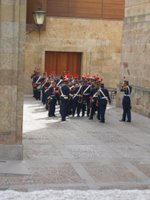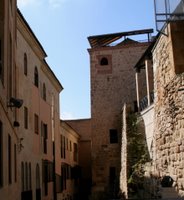An afternoon in Plasencia

I fall more in love with Extremadura every visit.
A fresh opportunity to wander an Extremeño town fell from brilliant blue Spanish skies Wednesday when a friend announced she would be driving to Plasencia, and wouldn't mind carting along a wandering blogger.
What is it about me and Extremadura?
Partly I suspect I just love the name.
I love the contrast between harsh sounding "Extremadura" and the proud, elegant towns I find there. Young Extremeños jumped at the chance to make their fortunes in the New World in the 16th century, and many of the most famous conquistadores - among them Cortés, the Pizarros, and Vasco Nuñez de Balboa, who discovered the Pacific Ocean - hailed from inland Extremadura.
 When I visited Trujillo in August, the Turismo guide insisted that the New World's riches landed in the Crown's accounts cien por cien while the returning conquistadores made fit with titles and Renaissance palaces. Extremadura is awash in stunning palaces, ornate Cathedrals and perfectly preserved medieval town centers, remnants of wealthier, more powerful days. An inland, out of the way place, Extremedura made it to the 21st century largely intact by growing modern towns around her architectural gems, seemingly without losing a single, well-placed stone.
When I visited Trujillo in August, the Turismo guide insisted that the New World's riches landed in the Crown's accounts cien por cien while the returning conquistadores made fit with titles and Renaissance palaces. Extremadura is awash in stunning palaces, ornate Cathedrals and perfectly preserved medieval town centers, remnants of wealthier, more powerful days. An inland, out of the way place, Extremedura made it to the 21st century largely intact by growing modern towns around her architectural gems, seemingly without losing a single, well-placed stone.  I arrived without a map, this being a fairly spontaneous wander, but I easily found my way to the Plaza Mayor.
I arrived without a map, this being a fairly spontaneous wander, but I easily found my way to the Plaza Mayor.Plasencia's Plaza Mayor is long and set somewhat akilter. Like the Plaza of Cáceres, it has a busy, things-to-do feel, carrying itself like a working plaza with places to go and groceries to buy.

The portly gentleman clinging to the bell tower of the 16th century town hall is the abuelo mayorga, and if we believe the waiter in the first cafe to the left, he's been waiting to ring the bells since the ayuntamiento was built.
Wandering through Plasencia's narrow streets on a hot spring day with the heady scent of orange blossoms hanging in the air, I felt absolutely nothing like the poor woman below, immortalized in stone, although I did consider her worth a photo. The palace of a less than happily married aristocratic couple, perhaps?
 Just beyond the Plaza Mayor I spotted a sign for the Plaza de las Catedrales, so I headed there next. Plasencia boasts two cathedrals: the new, 16th century model, never completed, and the Old Cathedral, a lovely 15th century specimen that has managed to hold on to an elegantly simple Romanesque facade despìte having been cannibalized during the construction of its younger sibling.
Just beyond the Plaza Mayor I spotted a sign for the Plaza de las Catedrales, so I headed there next. Plasencia boasts two cathedrals: the new, 16th century model, never completed, and the Old Cathedral, a lovely 15th century specimen that has managed to hold on to an elegantly simple Romanesque facade despìte having been cannibalized during the construction of its younger sibling. To escape the heat, I paid my 3 euros and visited the Old Cathedral's cool, green cloister and the striking Capilla de San Pablo, an odd mix of Romanesque and Gothic. I made one last stop before heading back into the sun: the reliquaries in the Cathedral museum, each sheltering a carefully labelled saint's appendage, or bone, or wisp of hair.

From the Cathedrals, I wandered to the Plaza San Nicolas, passing more palaces and Romanesque churches, then followed Plaza San Vicente Ferrer to the impressive Parador (state owned hotel), housed in the restored convent of San Vicente Ferrer. From the Parador I ducked under a stone arch into a cool, dark alley running between two palaces.
A small hand-lettered card on the door on the alley's right side caught my eye. Se puede visitar... The note offered a visit to two patios, a kitchen and a hunting museum, just for ringing the bell.
I rang.
Slowly, very, Spanish summer heat slowly, soft footsteps grew louder, until a grinning 40ish caretaker opened the door. He happily showed me in, then explained, in detail, why I could only see the rooms listed on the index card outside. (He carried on so much I wondered if I wasn't expected to offer money to see the absentee owner's private quarters, on the first floor.)
 From the lush, green patio of the younger palace (16th century) we crossed to the older palace, where we entered through a simple patio, just as meticulously maintained.
From the lush, green patio of the younger palace (16th century) we crossed to the older palace, where we entered through a simple patio, just as meticulously maintained. Thrilled to have a rapt audience, my guide escorted me through the hunting museum of the Marqués de No Se Cuál, mounted after his death by his eldest daughter. Heads, skulls, and horns covered the walls: jabalís, deer, mountain goats, wolves, a lynx, partridges, many with handwritten inscriptions of where and when they met the Marques' rifle. We wandered photo by photo in the museum's entryway, as my guide pointed out the collection's owner and his famous companions, among them Spain's King Alfonso XIII.
After checking out the ebony inlaid camp desk, we tramped back through the patio to the palace's highlight, an incredibly intact 13th century kitchen.
As we talked, the caretaker came to life, encouraging me to picture the preparations for a grand Medieval banquet here, smoke rising out of the firepits, unlucky young pigs turning over a spit, servants running in and out of the patio with platters of food. He giggled with delight when I commented on the coolness inside the palace's stone walls, and demanded I measure the thickness in arm-to-elbow measures (2 1/2). My host then took the opportunity to lament the rush of modern construction, when things have to be finished when the client demands, and not when the artesans, or their offspring, should doing the job well take more than one generation, carefully finish their work. Granted, he did comment on the fact that today's artesans are paid, which we agreed was an improvement as we headed back to the patio.
Our tour over, I wandered up through the judería back to Plaza Santa Ana, where I happily waited for my ride while savoring two claras and two delicious tapas (carne con salsa and salchichas, if you must know) for 2 euros at the bustling Café Santa Ana.
Wandering lesson of the the day: Never walk by a handwritten note taped to a very old door.
Labels: wanders and travels
































